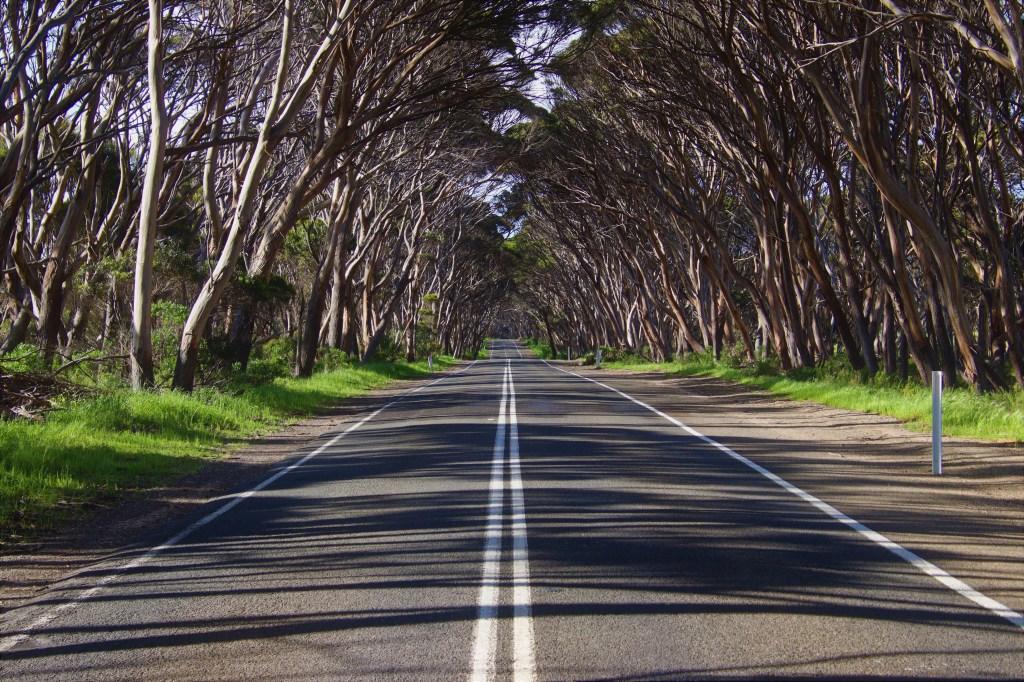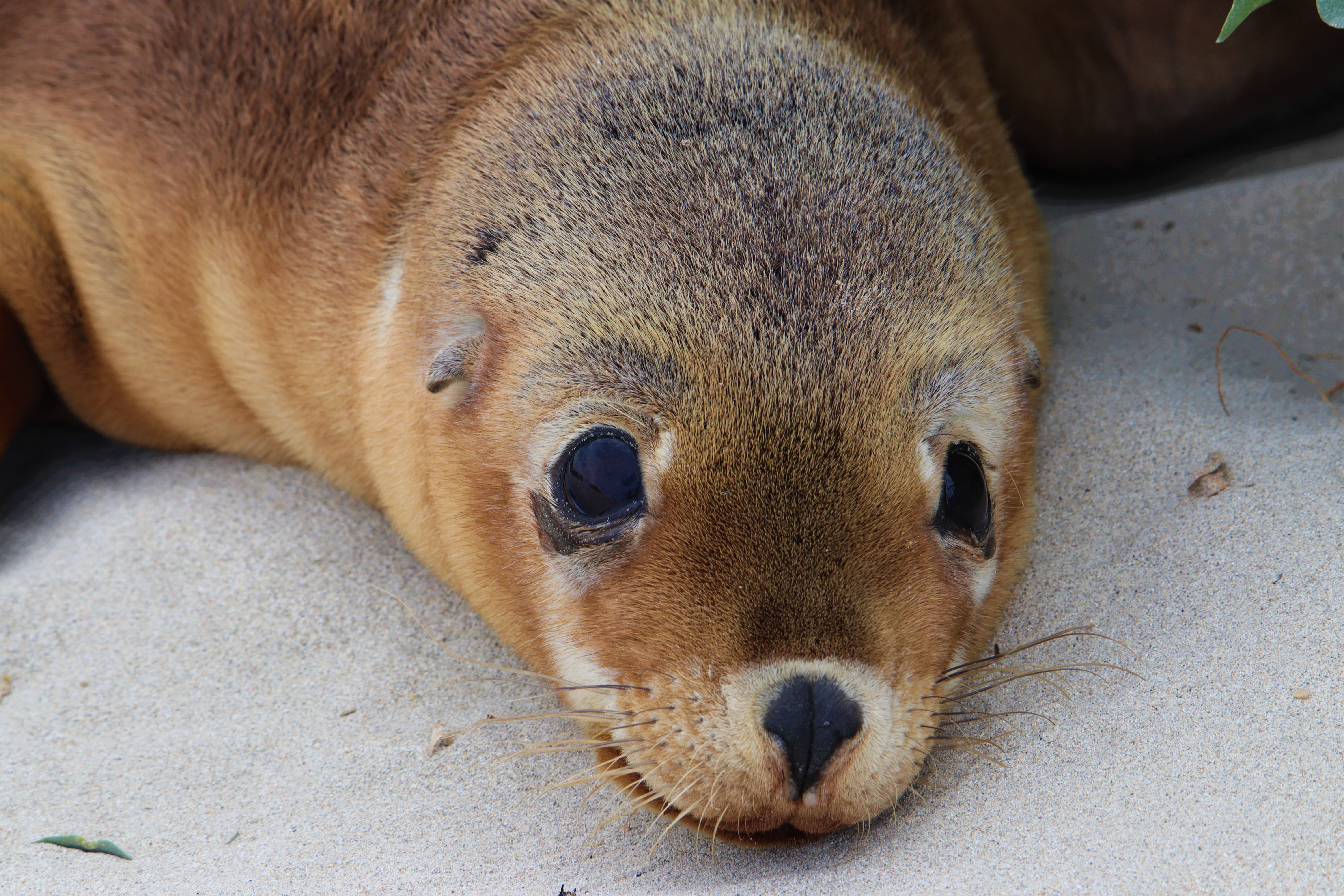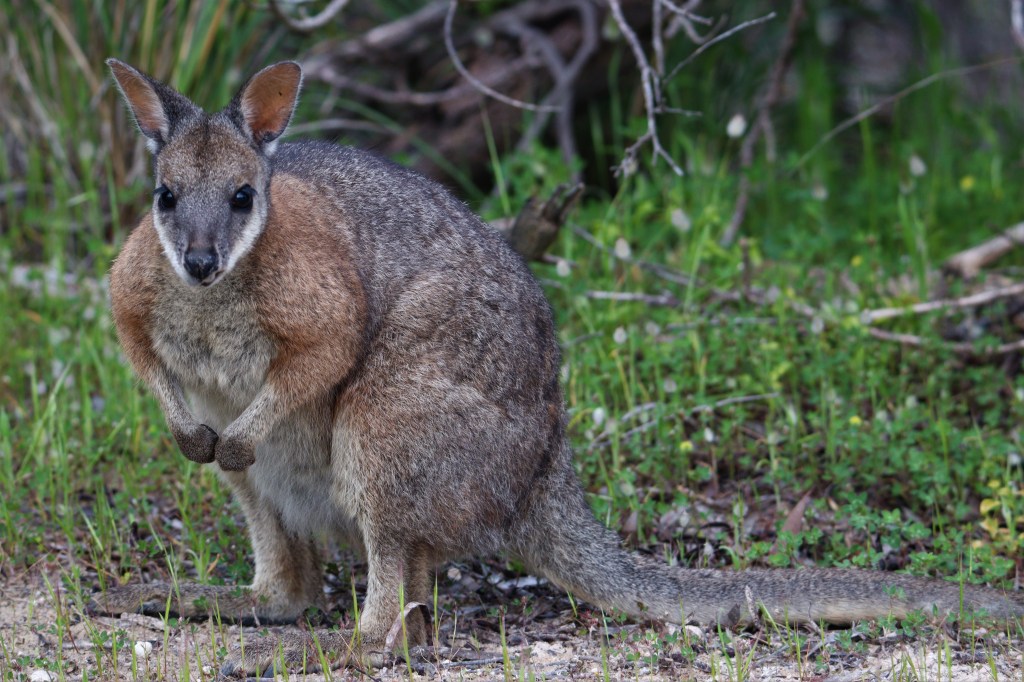Kaurna Country
I departed Warren Gorge in the Southern Ikara-Flinders Ranges while it was still pitch black in order to reach Cape Jervis at the bottom of the Fleurieu Peninsula, the departure point for the Kangaroo Island ferry. I had stopped in Adelaide on the way to pick up Lorenz who had flown in from Perth.
Continued from South Australia Part 2 of 4 – The Ikara-Flinders Ranges
A lunch stop had been made at the lovely town of Myponga, where although it was the middle of the day there was an abundance of Western Grey Kangaroos grazing around the town. There are numerous ferries plying the 45 minute route between Cape Jervis and Kangaroo Island (KI.) The cost for a vehicle and two passengers left very little change from $500.
https://www.sealink.com.au/kangaroo-island/
Kangaroo Island

Baudin Conservation Park.
The first night on KI was spent at the ferry port town of Penneshaw. After checking in to the accommodation and with daylight remaining, we drove to nearby Baudin Conservation Park on the outskirts of town where our first KI mammal was encountered.
The Kangaroo Island Kangaroo is a subspecies of the Western Grey Kangaroo. Subtle differences include the stockier build and darker fur, of which the latter is an adaptation to colder climate of the island.
The KI Kangaroo was an important source of protein for Matthew Flinders on his circumnavigation of Australia, and he gave the island the current name accordingly.
The name the indigenous Kaurna people call KI is Karta Pintingga, which translates as “Island of the dead.” Indigenous peoples had lived on KI before rising sea levels cut it off from the mainland 10,000 years ago, and for some time after, although the island was uninhabited at the time of the visit by Flinders.
KI Kangaroo.

The trailhead for the Ironstone Hill Trail is located at the small carpark on Binney’s Track. The trail descends steeply from the carpark to an open area with a small watercourse, flowing beautifully at the time of our visit. The walk then continues on to the far side of the valley up a long, steep hill and terminating at an old settlers cottage.
Ironstone Hill Walking Trail in Baudin Conservation Park.
Baudin Conservation Park contains stands of regenerating she-oak woodland, and the thick understory of this woodland provides important shelter for Tammar Wallabies.
The Tammar is Australia’s smallest wallaby attaining a maximum size of only 9kg. In common with most of Australia’s marsupials they are crepuscular / nocturnal.
The overcast conditions on the day of our visit meant the Tammars were active from 4pm. Over the course of three hours we saw approximately fifty Tammar Wallabies (and four KI Kangaroos) at Baudin Conservation Park.
Tammar Wallaby with Joey.

Offshore Islands are a stronghold for Tammar Wallabies from South Australia through to the West Coast of WA. They also occur on the mainland in Western Australia, where the best sites to view them include Tutanning and Perup Nature Reserves.
Mainland Tammars have to contend with foxes and large numbers of feral cats at these reserves and on account of predator avoidance behaviour can be hard to see. Kangaroo Island provides a wonderful opportunity to view this species which became ever more confiding as dusk fell.
Tammar Wallaby.

On a previous visit to KI, I had stayed at the fabulous KI Wilderness Lodge on the boundary of Flinders Chase National Park, the location served me well but unfortunately it was razed to the ground in the 2019-2020 fires that ravaged the Western part of the island.
A central location was preferable when choosing a base on the island and the township of American River best fitted this criteria, so the next morning we made the thirty minute there drive setting up for the next three nights.
Seal Bay
The drive from American River to Seal Bay takes an hour, and the weather had improved sufficiently over the drive to include brief sunny periods. The warmth had enticed a spiky Echidna from the undergrowth to forage. Kangaroo Island is touted as the one of the best places in Australia to see Echidnas and it undoubtedly is, alongside Western Australia’s Dryandra Woodland, and the entire island of Tasmania.
Echidna.

The famous inhabitants of Seal Bay are a colony of Australian Sea Lions. This paid attraction run by SA Parks and Wildlife has two options. The cheaper is a self guided walk along a 900m boardwalk through sand dunes, to a lookout over the beach.
Winter months on the boardwalk can be the most rewarding, when Sea Lions often haul up into the protected dunes affording close views. Prior to a guided tour we visited the boardwalk to find an adult Sea Lion resting beneath the boardwalk.
The more expensive option at $39 is a guided tour with Parks and Wildlife staff onto the beach itself. This provides an opportunity to observe the Sea Lions at close quarters, while of course still maintaining a respectful distance to these wild animals.
As our small group of six descended the wooden stairs to the beach we were delighted to be approached by a playful juvenile animal. The pup was sheltering in the dunes while the mother was out hunting the surrounding ocean.
Australian Sea Lion Cub.


The beach itself contained around forty Sea Lions and was a hive of activity. There were mothers with playful pups, groups of females, and males surfing the waves onto the beach causing havoc as they interacted with the females and each other.
Female Sea Lion.

That night back at American River, I set off on foot around the township for a brief spotlight. The cold, still air was thick with the smell of wood smoke, for Winter had not quite released it’s grip on the island. Tammar Wallabies were the only mammal seen but were in good numbers grazing the gardens of the town.
Flinders Chase National Park
Flinders Chase National Park is located on the Western end of Kangaroo Island. In 2019 – 2020 bushfires at Flinders Chase sparked by lightning devastated 38% of the island. In addition to the annhililation of the National Park, domestic animals and crops, homes, tourism businesses and two lives were lost. Despite two covid-foiled attempts to visit KI in 2020 and 2021 this was the first opportunity that presented to put essential tourist dollars back into the island economy.
See here for the previous visit to Kangaroo Island:- Wildlife South Australia – Wombats and Wallabies
Kangaroo Island is a deceptively large island, and the drive from American River to Flinders Chase National Park took ninety minutes. During the drive I was apprehensive of the devastation I would find at Flinders Chase, for I had such fond memories of this spectacular National Park from the previous visit. It was a sunny day, in fact the best weather of the entire time on KI, and accordingly we saw a total of four Echidnas on the drive to and from Flinders Chase.
Long before arrival at the National Park the effects of the fire were clear to see on plantations. The forests of sugar gums in Flinders Chase were also fire ravaged although epicormic shoots had sprouted, the first signs of a return to canopy.
The large open fields around the old visitor centre were filled with Cape Barren Geese, predominantly grazing birds they are usually found in areas of pasture. The distribution of Cape Barren Goose is along the South Coast of the Continent, usually on offshore granite islands.
In common with Koalas, Ringtail Possums and the Platypus the geese are an introduction to KI. This beautiful bird has many attractive features but none more so than the luminous chartreuse cere, perched on top of the bill.
Cape Barren Geese.


Macropods were an outside chance during the middle of the day, but there was a Koala asleep in a eucalypt outside the temporary visitor centre, It was heartening to see the Koala was clutching a young joey. At the visitor centre I enquired as to the fate of the Platypus population at Little River to find they had not been impacted by the fires..
The heathlands on approach to the coast have regenerated well, in fact in places the effects of the fires were not immediately obvious. Coastal Pigface in particular seemed to be running wild. The impressive Cape du Couedic Lighthouse stands sentinal at the coast above Admirals Arch and the carpark was busy with tourists making the most of the good weather.
Cape du Couedic Lighthouse.

A series of boardwalks and steps lead down from the lighthouse to Admirals Arch where despite the sunshine a biting wind was driving in from the ocean. The rocks around Admirals Arch are home to a colony of Long-nosed Fur seals.
The previous name for this species was the New Zealand Fur Seal. This is confusing because they occur along the South and West coasts of Australia, in the states of Western Australia, Tasmania and South Australia. The South Australian colonies make up the majority of the Australian population.
Descending the wooden stairs to Admirals Arch there were the usual seals dotted around the adjacent rocks, while inside the actual arch itself was a large male fast asleep on a rock ledge. The seals feed on squid and baitfish in the open ocean and have been recorded diving to an incredible depth of 380m.
Long-nosed Fur Seal.

The external ears on the Long-nosed Fur Seal is one difference with the “true” earless seals. See the handy article below by Californian Parks and Wildlife explaining further differences.
https://www.nps.gov/redw/learn/nature/true-seals-versus-fur-seals-and-sea-lions.htm
Admiral’s Arch.

We visited nearby Remarkable Rocks but it was a busy time of the day and the bright sunlight and numerous people ruled out any serious photography so I decided to return early the following morning.
American River
I made the most of the good weather late afternoon back at American River. The town looks out over the appropriately named Pelican Lagoon and there were plenty of waterbirds dotted around the shores.
Pelicans American River.

An alternate route to American River is along Muston Road that links Hog Bay Road with American River Road. This unsealed road passes through coastal vegetation with stands of tea tree that provides shelter for Tammar Wallabies. A drive along Muston Road that evening revealed seven Tammar Wallabies and two KI Kangaroos.
Tammar Wallaby.

Remarkable Rocks
I left Lorenz fast asleep the following morning to make the long drive across the island to reach Remarkable Rocks for sunrise. Slow speeds are mandatory for night driving on KI on account of the large amount of wildlife roaming the island, and over the course of the journey I encountered all of Tammar Wallabies, Kangaroos and Brushtail Possums on the road.
A combination of the early hour and cold, showery conditions ensured I was alone at Remarkable Rocks that morning. The copious cloud occluded sunrise but the overcast conditions highlighted the fabulous rusty-orange colour of the lichens that adorn the rocks.
Remarkable Rocks.

On the return drive near the Cape du Couedic lighthouse Tammar Wallabies had ventured onto the quiet road from a stand of fire unaffected tea tree. Wildlife it seems is back at Flinders Chase with avengence.
The wet weather had been disappointing during the time on KI, although the overcast conditions contributed to increased daytime Tammar Wallaby activity. Meanwhile at the Gawler Ranges that I would visit the following week the weather had been perfect.
Continued in South Australia Part 4 of 4 – Adelaide, Brookfield, The Gawler Ranges.
#QuollingAround
2 thoughts on “South Australia Part 3 of 4 – Kangaroo Island”